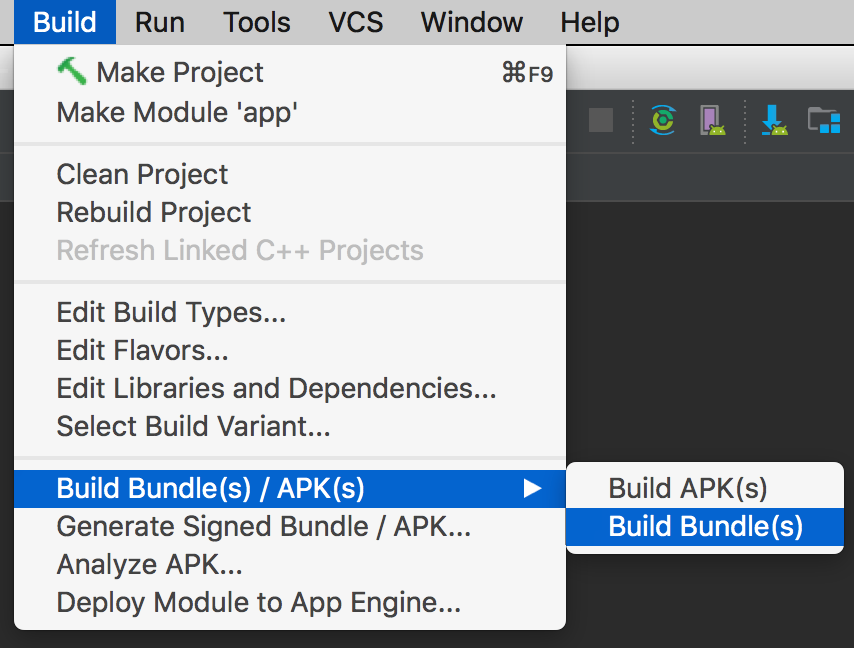Android Studio 3.2 Beta
Posted by Jamal Eason, Product Manager, Android
Starting today, you can download Android Studio 3.2 Beta. Previewed at Google I/O 2018, the latest release of the official Android IDE is focused on helping onboard you to all the new features launched around Google I/O -- Android JetPack, Android P Developer Preview, and the new Android App Bundle format. There are also several other exciting new features included in Android Studio 3.2 to accelerate your app development, such as Emulator Snapshots and the Energy Profiler.
As the usage of Android Studio has grown in the 3.5 years since version 1.0, we have also become increasingly obsessed with quality. We continue to invest in quality because we know that millions of app developers spend almost everyday in Android Studio and need a reliable set of tools. Stability, build times, and other quality work will be the primary focus for our next release once we finish Android Studio 3.2. We also did not want to wait, so we have made checkins to address memory leaks and performance issues as well as fixed more than 450 bugs. Thank you for the continued feedback and please keep it coming so we can focus on the areas you care about most in the next version of Android Studio. If want to try out the latest features, and assess the improvements in quality, you can download Android Studio on the beta release channel.
What is inside of Android Studio 3.2
Building on the canary release of Android Studio 3.2, the Beta release includes:
- Android App Bundle support - The Android App Bundle is a new publishing format that uses the Google Play's Dynamic Delivery, which delivers a smaller, optimized APK that only contains the resources needed for a specific device. Without any code changes, you can take advantage of the app size savings of an Android App Bundle by navigating to Build → Build Bundle / APK or Build → Generate Signed Bundle / APK.
Build Android App Bundle
- Emulator Snapshots - With Android Studio 3.2 you can create snapshots at any emulator state and then start a snapshot in under 2 seconds. You can pre-configure an Android Virtual Device (AVD) snapshot with the apps, data and settings that you want and then repeatedly go back to the same snapshot. Learn more.
Android Emulator Snapshots
- Energy Profiler - The new Energy Profiler in the performance profiler suite can help you understand the energy impact of your app on an Android device. You can now visualize the estimated energy usage of system components, plus inspect background events that may contribute to battery drain.
Energy Profiler
Check out the full write-up of all the major features organized by development flow listed below and on the canary blog:
Develop
| Test
|
Sessions at Google I/O '18
With the release of Android Studio 3.2 at Google I/O '18, the Android Studio team also presented a series of sessions about Android Studio. Watch the following videos to see the latest features in action and to get tips & tricks on how to use Android Studio:
- What's new in Android development tools
An overview of all the recent features in Android Studio for Android app developers. The session includes demos and a tour de force presentation of relevant features that will accelerate developers' workflow on the latest Android APIs. - What's new with the Android build system
A deep dive into the new features of the Android build system. - What's new with ConstraintLayout and Android Studio design tools
This session covers the new features in ConstraintLayout 2.0, as well as the latest functionality added in Android Studio design tools, highlighting how to effectively take advantage of them for designing, prototyping, and building a graphical user interface application. - Improve app performance with Android Studio Profilers
This talk demonstrates how to diagnose and troubleshoot performance problems with your app using Android Studio Profilers. It covers examples of how to use the CPU, memory, network profilers, and highlight what's new. - Best practices using compilers in Android Studio
This session discusses in-depth what is happening to the various compilers used in Android: Java 8 language feature desugaring, the new dexer (D8) and shrinker (R8), and work done on the Kotlin compiler for Android use. - Android Jetpack: manage UI navigation with Navigation Controller
This session discusses how to use the Navigation Editor in Android Studio, XML or the Java API to define your navigation graph, and how that simplifies navigating around your app and handling deep linking.
Download & Feedback
Download the latest version of Android Studio 3.2 from the beta channel download page. If you are using a previous versions of Android Studio, make sure you update to Android Studio Beta 1 or higher. If you also want to maintain a stable version of Android Studio, you can run the stable release version and beta release versions of Android Studio at the same time. Learn more.
To use the mentioned Android Emulator features make sure you are running at least Android Emulator v27.3+ downloaded via the Android Studio SDK Manager.
Please note, to ensure we maintain product quality, some of the features you saw in the canary channel like Navigation Editor are not enabled by default. To turn on canary release channel features go to File → Settings → Experimental → Editor → Enable Navigation Editor.
If you find a bug or issue, feel free to file an issue. Connect with us -- the Android Studio development team ‐ on our Google+ page or on Twitter.







Komentar
Posting Komentar